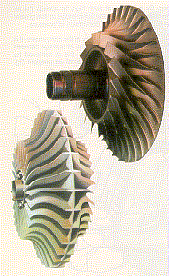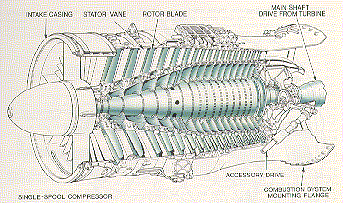 Back to the Purdue AAE Propulsion main page.
Back to the Purdue AAE Propulsion main page.
 Back to the Turbine Engine Basics page.
Back to the Turbine Engine Basics page.
 Back to the Purdue AAE Propulsion main page.
Back to the Purdue AAE Propulsion main page.
 Back to the Turbine Engine Basics page.
Back to the Turbine Engine Basics page.
| A compressor ``stage'' is made up of a moving part (the impeller, or rotor) and a stationary part (the diffuser, or stator). In most devices, pressure rises occur across both portions of the stage. | |
 |
Compressors fall into two broad categories. The first type
of compressor is the centrifugal or annular compressor. Its
impeller accelerates the flow by flinging it outward. This also increases
the pressure. The pressure is increased further, and the flow is slowed, when
the flow meets the diffusers that ring the impeller.
Advantages of the centrifugal compressor are that it is easier to design and manufacture, and it can often increase the pressure enough for efficient combustion with only one stage. However, the airflow for a centrifugal compressor is much lower than for an axial, and its pressure ratio is generally lower, meaning it is much less effective for creating thrust and less fuel- efficient. Hence, it is more often seen in small engines, where the the manufacturung advantages outweigh the performance disadvantages; in shaft engines, where thrust is less of a concern; and in industrial applications, where thrust is no concern at all. (The turbocharger in many sports cars is composed of a centrifugal compressor and turbine.) |
 |
The other type
of compressor is the axial flow compressor.
While axial compressors can accomodate more airflow than a centrifugal
design of the same size, a rotor/stator stage generally does not provide
enough compression for most applications. For this reason, multistage
devices are generally employed. Modern engines can use 10-15 compressor
stages.
Advantages of the axial compressor are its higher flow rate and greater pressure ratio, which results in higher thrust and fuel efficiency. This makes it better suited to applications where the thrust of the engine itself is the motive force for the aircraft. |
 Back to the Purdue AAE Propulsion main page.
Back to the Purdue AAE Propulsion main page.
 Back to the Turbine Engine Basics page.
Back to the Turbine Engine Basics page.